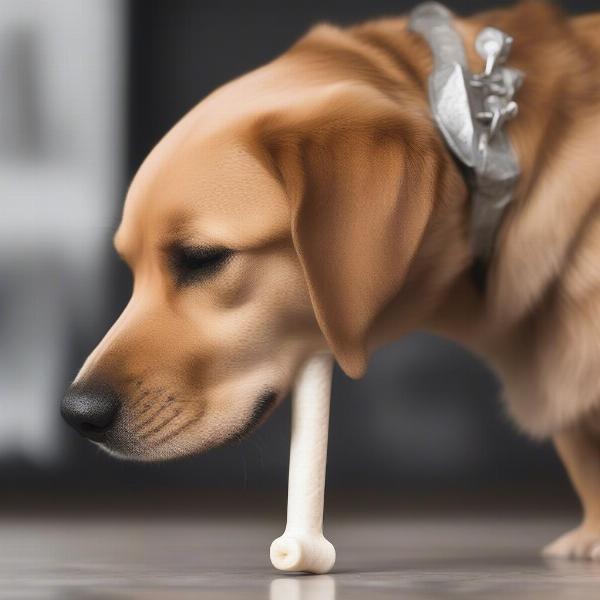Dual dog bones, also known as double-sided bones, are a popular chew toy for dogs. But are they the right choice for your furry friend? This comprehensive guide will explore everything you need to know about dual dog bones, from their benefits and drawbacks to choosing the right size and material. We’ll also discuss safety tips and alternatives to consider.
Understanding the Appeal of Dual Dog Bones
Dual dog bones are designed with two chewing surfaces, offering dogs double the chewing pleasure. This can be especially appealing for power chewers who quickly demolish single-sided bones. The shape also often allows dogs to hold the bone securely between their paws while gnawing. However, it’s important to understand the potential risks associated with these bones, as well as the benefits they offer.
Benefits of Dual Dog Bones
- Dental Health: Chewing on a dual dog bone can help scrape away plaque and tartar buildup, promoting good oral hygiene and fresher breath. This can be particularly beneficial for dogs prone to dental issues.
- Mental Stimulation: The act of chewing provides mental stimulation, helping to alleviate boredom and prevent destructive behaviors, especially in energetic breeds.
- Jaw Exercise: Gnawing on a dual dog bone strengthens jaw muscles and provides a healthy outlet for natural chewing instincts.
Potential Drawbacks and Safety Concerns
While dual dog bones can be enjoyable for dogs, it’s crucial to be aware of potential downsides:
- Choking Hazard: Small pieces can break off, especially with brittle bones, posing a choking hazard. Always supervise your dog while they’re chewing.
- Tooth Damage: Extremely hard bones can chip or fracture teeth, particularly in older dogs or those with pre-existing dental problems.
- Digestive Issues: Swallowing large chunks can lead to digestive upset, blockages, or constipation.
Choosing the Right Dual Dog Bone
Selecting the appropriate dual dog bone is crucial for your dog’s safety and enjoyment. Consider the following factors:
- Size: Choose a bone that’s appropriately sized for your dog’s breed and chewing habits. A bone that’s too small can be a choking hazard, while a bone that’s too large can be difficult to manage.
- Material: Opt for durable, non-toxic materials like nylon or rubber. Avoid bones made of cooked bones or brittle materials that can easily splinter. Natural materials like antlers can be a good option, but ensure they are sourced ethically and sustainably.
- Durability: Consider your dog’s chewing strength. If you have a power chewer, choose a bone designed specifically for aggressive chewing.
 A dog happily chewing a dual dog bone
A dog happily chewing a dual dog bone
Alternatives to Dual Dog Bones
If you’re concerned about the potential risks of dual dog bones, consider these alternatives:
- Dental Chews: Designed specifically for dental health, these chews are often softer and more digestible.
- Rope Toys: Durable rope toys provide a satisfying chewing experience and can also be used for interactive play.
- Treat-Dispensing Toys: These toys offer mental stimulation and keep dogs entertained while providing a healthy treat.
Are Dual Dog Bones Right for Your Dog?
Dual dog bones can be a great way to satisfy your dog’s natural chewing instincts and promote dental health. However, it’s essential to choose the right bone and supervise your dog while they’re chewing. If you’re unsure whether a dual dog bone is suitable for your dog, consult your veterinarian.
Conclusion
Dual dog bones can provide enjoyment and dental benefits for dogs, but careful selection and supervision are crucial. By understanding the potential risks and choosing the appropriate bone, you can ensure your dog’s safety and chewing satisfaction. Always prioritize your dog’s health and well-being when selecting any chew toy.
FAQ
- Are dual dog bones safe for puppies? While puppies have a strong urge to chew, dual dog bones may not be the best option due to their developing teeth. Consult your veterinarian for recommendations.
- What should I do if my dog breaks a piece off their dual dog bone? Remove the bone immediately and discard any broken pieces. Monitor your dog for any signs of digestive distress.
- How often should I give my dog a dual dog bone? Dual dog bones should be given as an occasional treat rather than a daily chew. Over-chewing can lead to dental problems.
- Can I give my senior dog a dual dog bone? Senior dogs may have weaker teeth, making them more susceptible to tooth damage from hard bones. Choose softer chews or consult your veterinarian.
- What are some signs that my dog’s dual dog bone is too hard? If your dog struggles to make an indent in the bone, or if you hear a cracking sound when they chew, the bone may be too hard.
- Can dual dog bones help with teething puppies? While chewing can help soothe teething pain, choose puppy-specific teething toys designed for their delicate gums and developing teeth.
- How do I clean a dual dog bone? Follow the manufacturer’s instructions for cleaning. Some bones can be washed with soap and water, while others may be dishwasher safe.
ILM Dog is a leading online resource for dog owners worldwide, offering expert advice on all aspects of dog care, from breed selection and health to training, nutrition, and grooming. We provide practical, reliable information to help you give your furry friend the best possible care. Whether you’re a new dog owner or a seasoned expert, ILM Dog has the resources you need. Contact us at [email protected] or +44 20-3965-8624 for any inquiries.